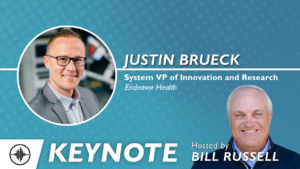

April 10, 2025

April 3, 2025
December 1, 2025
A recent study by Mass General Brigham and Ariadne Labs has demonstrated that hospital-at-home programs can effectively serve rural communities, yielding strong patient outcomes and lower costs. Conducted with 161 adults across three rural hospitals, the research showed that patients receiving home care had comparable safety and readmission rates to those treated in traditional settings, with early transfers to home care leading to improved mobility. The notable increase in patient satisfaction also highlights the potential benefits of these programs in enhancing the quality of care in underserved areas. This suggests that healthcare technology can play a vital role in addressing access gaps, particularly in rural healthcare delivery.
Rural Hospital-at-Home Programs Thrive, Offering Safe Cost-Effective Care Chief Healthcare Executive
December 1, 2025
On November 26, OpenAI confirmed a security breach linked to its APIs, which was traced back to Mixpanel, a product analytics platform, following unauthorized access discovered on November 9. The breach exposed limited customer identifiable information, such as names and email addresses, affecting only API accounts, while everyday ChatGPT user accounts remained secure. This incident underscores the vulnerabilities associated with third-party integrations in healthcare technology, raising concerns about data privacy and security for users utilizing these APIs. Consequently, healthcare professionals must prioritize understanding API functionality and implementing robust security measures to safeguard against similar threats.
OpenAI Security Breach Exposes API User Data Amid Mixpanel Attack Forbes
December 1, 2025
Matt Christensen's appointment as the Assistant Vice President and Deputy Chief Information Security Officer at Intermountain Health underscores the growing importance of cybersecurity in healthcare. With his focus on enhancing information security strategies, Christensen is poised to play a critical role in protecting sensitive patient data amidst ongoing digital transformation in the sector. His acknowledgment of teamwork highlights the collaborative approach necessary for effective security practices. This leadership change is significant as healthcare organizations grapple with increasing cyber threats and the need for compliance with stringent industry regulations.
Matt Christensen Joins Intermountain Health as Deputy CISO Amid Cybersecurity Surge I'm sorry
December 1, 2025
A jury in Minnesota recently awarded nearly $20 million to an Iowa woman who sued Mayo Clinic for medical negligence after a multistage colorectal-cancer surgery in 2018. According to the plaintiff’s attorneys, the surgeon failed to remove 5–7 cm of diseased rectal tissue, proceeded with a third surgery despite evidence (a CT scan) of remaining diseased tissue, and left the patient with permanent disfigurement, chronic pain, and other serious complications including pelvic-floor disorder, fibromyalgia, and PTSD. The verdict covers past and future pain and suffering, reflecting the jury’s conclusion that the standard of care was breached — a verdict the Mayo Clinic disputes, though it acknowledged the jury’s judgment.
Minnesota Jury Awards $20M in Mayo Clinic Negligence Case Health Exec
December 1, 2025
A recent study by Mass General Brigham and Ariadne Labs has demonstrated that hospital-at-home programs can effectively serve rural communities, yielding strong patient outcomes and lower costs. Conducted with 161 adults across three rural hospitals, the research showed that patients receiving home care had comparable safety and readmission rates to those treated in traditional settings, with early transfers to home care leading to improved mobility. The notable increase in patient satisfaction also highlights the potential benefits of these programs in enhancing the quality of care in underserved areas. This suggests that healthcare technology can play a vital role in addressing access gaps, particularly in rural healthcare delivery.
Rural Hospital-at-Home Programs Thrive, Offering Safe Cost-Effective Care Chief Healthcare Executive
December 1, 2025
On November 26, OpenAI confirmed a security breach linked to its APIs, which was traced back to Mixpanel, a product analytics platform, following unauthorized access discovered on November 9. The breach exposed limited customer identifiable information, such as names and email addresses, affecting only API accounts, while everyday ChatGPT user accounts remained secure. This incident underscores the vulnerabilities associated with third-party integrations in healthcare technology, raising concerns about data privacy and security for users utilizing these APIs. Consequently, healthcare professionals must prioritize understanding API functionality and implementing robust security measures to safeguard against similar threats.
OpenAI Security Breach Exposes API User Data Amid Mixpanel Attack Forbes
December 1, 2025
Matt Christensen's appointment as the Assistant Vice President and Deputy Chief Information Security Officer at Intermountain Health underscores the growing importance of cybersecurity in healthcare. With his focus on enhancing information security strategies, Christensen is poised to play a critical role in protecting sensitive patient data amidst ongoing digital transformation in the sector. His acknowledgment of teamwork highlights the collaborative approach necessary for effective security practices. This leadership change is significant as healthcare organizations grapple with increasing cyber threats and the need for compliance with stringent industry regulations.
Matt Christensen Joins Intermountain Health as Deputy CISO Amid Cybersecurity Surge I'm sorry
December 1, 2025
A jury in Minnesota recently awarded nearly $20 million to an Iowa woman who sued Mayo Clinic for medical negligence after a multistage colorectal-cancer surgery in 2018. According to the plaintiff’s attorneys, the surgeon failed to remove 5–7 cm of diseased rectal tissue, proceeded with a third surgery despite evidence (a CT scan) of remaining diseased tissue, and left the patient with permanent disfigurement, chronic pain, and other serious complications including pelvic-floor disorder, fibromyalgia, and PTSD. The verdict covers past and future pain and suffering, reflecting the jury’s conclusion that the standard of care was breached — a verdict the Mayo Clinic disputes, though it acknowledged the jury’s judgment.
Minnesota Jury Awards $20M in Mayo Clinic Negligence Case Health Exec

April 8, 2025

April 2, 2025

Questions about the Podcast?
Contact us with any questions, requests, or comments about the show. We love hearing your feedback.

© Copyright 2024 Health Lyrics All rights reserved